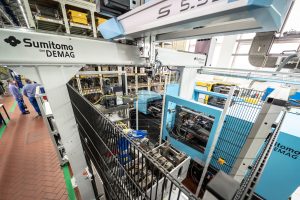
Firms partner on a new manufacturing cell for thermoplastic polymers
Canadian Plastics
Plastics Processes Research & Development Robots & AutomationDeveloped by BASF, Sumitomo (SHI) Demag and H + S Automatisierung, the cell can produce a wide range of different test specimens.

Photo Credit: BASF
Product development and research activities are big deals in the world of high-performance polymer molding, which is why engineers with BASF’s Performance Materials division have collaborated with machinery maker Sumitomo (SHI) Demag and automation supplier H + S Automatisierung to create an innovative manufacturing cell that can produce a wide range of different test specimens.
The cell – which was built and is housed at BASF’s injection molding and extrusion pilot plant in Ludwigshafen, Germany – combines Sumitomo (SHI) Demag’s IntElect 1000 kN injection molding machine with a linear SDR 5-35S robot. The robot serves two purposes, BASF officials said: A new feature is fully automating the selection and placement of one of 12 interchangeable mold inserts from a magazine located within the cell. The change of the mold inserts is synchronized to the cell control via output and input signals with the transmission of the new mold data record via the robot interface. After the change of the mold insert, the temperature control units are heated up again. Automatic operation resumes and a new mold data record is initiated as soon as the target temperature is reached.
After the part is molded, the same robot fitted with a multi-functional gripper gently extracts the test specimen from the mold and passes it to the small six-axis articulated-arm Yaskawa GP8 robot for the precise cut of the specimens from the gate using a servo spindle drive punching machine. The multi-functional gripper ensures all sample geometries are placed with exacting precision onto the punch plate.
Integrating BASF’s existing mold insert concept and special features into the injection unit, the installation also includes an existing thermal temperature control unit and a new digital manufacturing execution system (MES) to map each test sequence. BASF’s MES informs the cell when the current produced sample setting is about to end, lining up the next mold application. Immediately after the injection process stops, the cooling of the mold insert is directed by the integrated temperature control unit interface. “Unlike our former MES systems, this one logs every single aspect of a trial and the results, giving us insight for every single shot,” said Angelika Homes, senior project engineer at BASF. “This data is extremely valuable as it represents the entire processing sequence and enables us to draw deeper conclusions about how materials perform under certain conditions and how a customer might later process it. This new cell validates the importance of automation and digitalization in material developments and component simulations and design.”
Many of the specimens being tested at BASF’s Ludwigshafen plant are high-temperature thermoplastics, fibre reinforced and often flame retardant, which means that melt temperatures can reach up to 400°C with mold temperatures hitting up to 180°C. At any time, up to 12 interchangeable inserts can be loaded to the side magazine and then swapped automatically into the injection molding machine. By integrating a HB-Therm temperature control system with Sumitomo (SHI) Demag’s machine control, automated mold insert changes can be completed safely and efficiently, even when running the process at high mold temperatures. “In order to lower the temperature to 80°C and depressurize the insert to guarantee that the SDR robot could remove the mold insert safely, our machine control has to talk and interact seamlessly with BASF’s MES,” said Markus Hausmann, an automation systems senior engineer at Sumitomo (SHI) Demag.
For BASF, solving the punch challenge was one of the greatest engineering accomplishments. Due to its extensive application profile, BASF tests a wide range of materials – from soft and tough to stiff and brittle polymers. There are also many different sample geometries, including thicknesses varying from 0.8 mm to 4 mm. All BASF test specimens are manufactured as per the ISO 294 standard. This specifies the precision of the sprue system and specific requirements each sample geometry must fulfill. “Removal by a punch is a prerequisite, as it does not change the material properties and eliminates dust particles,” said Markus Hausmann.
Additionally, the control program of the cell can be adapted to different materials, sample geometries, temperatures and processing parameters. Every single setting that runs is recorded and documented digitally.
